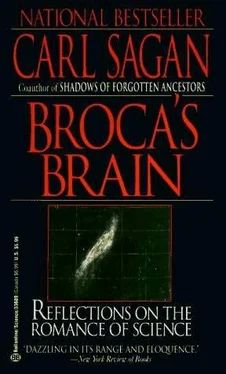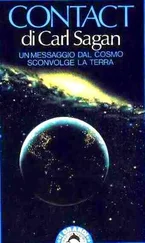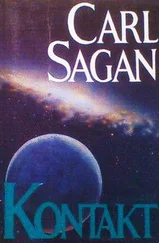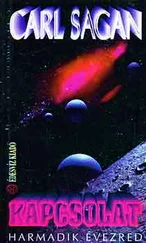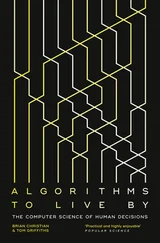Carl Sagan - Broca's Brain - The Romance of Science
Здесь есть возможность читать онлайн «Carl Sagan - Broca's Brain - The Romance of Science» весь текст электронной книги совершенно бесплатно (целиком полную версию без сокращений). В некоторых случаях можно слушать аудио, скачать через торрент в формате fb2 и присутствует краткое содержание. Жанр: Физика, на английском языке. Описание произведения, (предисловие) а так же отзывы посетителей доступны на портале библиотеки ЛибКат.
- Название:Broca's Brain: The Romance of Science
- Автор:
- Жанр:
- Год:неизвестен
- ISBN:нет данных
- Рейтинг книги:3 / 5. Голосов: 1
-
Избранное:Добавить в избранное
- Отзывы:
-
Ваша оценка:
- 60
- 1
- 2
- 3
- 4
- 5
Broca's Brain: The Romance of Science: краткое содержание, описание и аннотация
Предлагаем к чтению аннотацию, описание, краткое содержание или предисловие (зависит от того, что написал сам автор книги «Broca's Brain: The Romance of Science»). Если вы не нашли необходимую информацию о книге — напишите в комментариях, мы постараемся отыскать её.
Broca's Brain: The Romance of Science — читать онлайн бесплатно полную книгу (весь текст) целиком
Ниже представлен текст книги, разбитый по страницам. Система сохранения места последней прочитанной страницы, позволяет с удобством читать онлайн бесплатно книгу «Broca's Brain: The Romance of Science», без необходимости каждый раз заново искать на чём Вы остановились. Поставьте закладку, и сможете в любой момент перейти на страницу, на которой закончили чтение.
Интервал:
Закладка:
There is much about the Jovian magnetosphere and radio emissions that we still do not understand. The details of the decameter emissions are still deeply mysterious. Why are there localized sources of decameter emission on Jupiter probably less than 100 kilometers in size? What are these emission sources? Why do the decameter emission regions rotate about the planet with a very high time precision-better than seven significant figures-but different from the rotation periods of visible features in the Jovian clouds? Why do the decameter bursts have a very intricate (submillisecond) fine structure? Why are the decameter sources beamed-that is, not emitting in all directions equally? Why are the decameter sources intermittent-that is, not “on” all the time?
These mysterious properties of the Jovian decameter emission are reminiscent of the properties of pulsars. Typical pulsars have magnetic fields a trillion times larger than Jupiter’s; they rotate 100,000 times faster; they are a thousandth as old; they are a thousand times more massive. The boundary of the Jovian magneto-sphere moves at less than one thousandth of the speed of the light cone of a pulsar. Nevertheless, it is possible that Jupiter is a kind of pulsar that failed, a local and quite unprepossessing model of the rapidly rotating neutron stars, which are one end product of stellar evolution. Major insights into the still baffling problems of pulsar emission mechanisms and magnetosphere geometries may follow from close-up spacecraft observation of Jovian decameter emission-for example, by NASA’s Voyager and Galileo missions.
EXPERIMENTAL ASTROPHYSICS is developing rapidly. In another few decades at the very latest, we should see direct experimental investigation of the interstellar medium: the heliopause-the boundary between the region dominated by the solar wind and that dominated by the interstellar plasma-is estimated to lie at not much more than 100 astronomical units (9.3 billion miles) from the Earth. (Now, if there were only a local solar system quasar and a backyard black hole-nothing fancy, you understand, just little baby ones-we might with in situ spacecraft measurements check out the greater body of modern astrophysical speculation.)
If we can judge by past experience, each future venture in experimental spacecraft astrophysics will find that (a) a major school of astrophysicists was entirely right; (b) no one agreed on which school it was that was right until the spacecraft results were in; and (c) an entire new corpus of still more fascinating and fundamental problems was unveiled by the space vehicle results.
CHAPTER 20

WILLIAM SHAKESPEARE,
Thou com’st in such a questionable shape
That I will speak to thee…
Hamlet , Act I, Scene 4
THE WORD “ROBOT,” first introduced by the Czech writer Karel Čapek, is derived from the Slavic root for “worker.” But it signifies a machine rather than a human worker. Robots, especially robots in space, have often received derogatory notices in the press. We read that a human being was necessary to make the terminal landing adjustments on Apollo 11, without which the first manned lunar landing would have ended in disaster; that a mobile robot on the Martian surface could never be as clever as astronauts in selecting samples to be returned to Earth-bound geologists; and that machines could never have repaired, as men did, the Skylab sunshade, so vital for the continuance of the Skylab mission.
But all these comparisons turn out, naturally enough, to have been written by humans. I wonder a small self-congratulatory element, a whiff of human chauvinism, has not crept into these judgments. Just as whites can sometimes detect racism and men can occasionally discern sexism, I wonder whether we cannot here glimpse some comparable affliction of the human spirit-a disease that as yet has no name. The word “anthropocentrism” does not mean quite the same thing. The word “humanism” has been pre-empted by other and more benign activities of our kind. From the analogy with sexism and racism I suppose the name for this malady is “speciesism”-the prejudice that there are no beings so fine, so capable, so reliable as human beings.
This is a prejudice because it is, at the very least, a prejudgment, a conclusion drawn before all the facts are in. Such comparisons of men and machines in space are comparisons of smart men and dumb machines. We have not asked what sorts of machines could have been built for the $30-or-so billion that the Apollo and Skylab missions cost.
Each human being is a superbly constructed, astonishingly compact, self-ambulatory computer-capable on occasion of independent decision making and real control of his or her environment. And, as the old joke goes, these computers can be constructed by unskilled labor. But there are serious limitations to employing human beings in certain environments. Without a great deal deal of protection, human beings would be inconvenienced on the ocean floor, the surface of Venus, the deep interior of Jupiter, or even on long space missions. Perhaps the only interesting results of Skylab that could not have been obtained by machines is that human beings in space for a period of months undergo a serious loss of bone calcium and phosphorus-which seems to imply that human beings may be incapacitated under 0 g for missions of six to nine months or longer. But the minimum interplanetary voyages have characteristic times of a year or two. Because we value human beings highly, we are reluctant to send them on very risky missions. If we do send human beings to exotic environments, we must also send along their food, their air, their water, amenities for entertainment and waste recycling, and companions. By comparison, machines require no elaborate life-support systems, no entertainment, no companionship, and we do not yet feel any strong ethical prohibitions against sending machines on one-way, or suicide, missions.
Certainly, for simple missions, machines have proved themselves many times over. Unmanned vehicles have performed the first photography of the whole Earth and of the far side of the Moon; the first landings on the Moon, Mars and Venus; and the first thorough orbital reconnaissance of another planet, in the Mariner 9 and Viking missions to Mars. Here on Earth it is increasingly common for high-technology manufacturing-for example, chemical and pharmaceutical plants-to be performed largely or entirely under computer control. In all these activities machines are able, to some extent, to sense errors, to correct mistakes, to alert human controllers some great distance away about perceived problems.
The powerful abilities of computing machines to do arithmetic-hundreds of millions of times faster than unaided human beings-are legendary. But what about really difficult matters? Can machines in any sense think through a new problem? Can they make discussions of the branched-contingency tree variety which we think of as characteristically human? (That is, I ask Question 1; if the answer is A, I ask Question 2; but if the answer is B, I ask Question 3; and so on.) Some decades ago the English mathematician A. M. Turing described what would be necessary for him to believe in machine intelligence. The condition was simply that he could be in teletype communication with a machine and be unable to tell that it was not a human being. Turing imagined a conversation between a man and a machine of the following quality:
INTERROGATOR: In the first line of your sonnet which reads “Shall I compare thee to a Summer’s day,” would not “a Spring day” do as well or better?
WITNESS: It wouldn’t scan.
Читать дальшеИнтервал:
Закладка:
Похожие книги на «Broca's Brain: The Romance of Science»
Представляем Вашему вниманию похожие книги на «Broca's Brain: The Romance of Science» списком для выбора. Мы отобрали схожую по названию и смыслу литературу в надежде предоставить читателям больше вариантов отыскать новые, интересные, ещё непрочитанные произведения.
Обсуждение, отзывы о книге «Broca's Brain: The Romance of Science» и просто собственные мнения читателей. Оставьте ваши комментарии, напишите, что Вы думаете о произведении, его смысле или главных героях. Укажите что конкретно понравилось, а что нет, и почему Вы так считаете.
